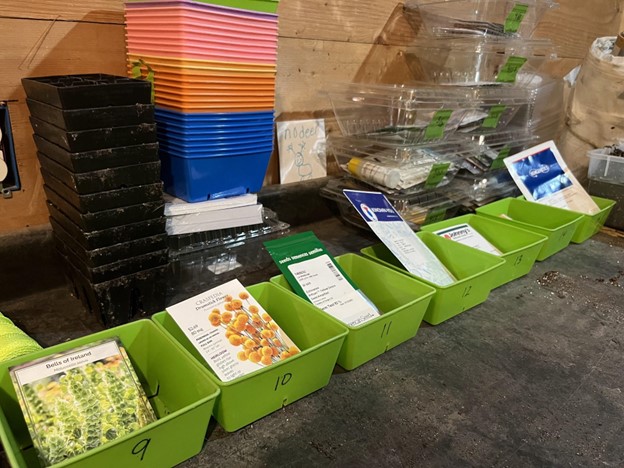
Maine Home Garden News – March 2025
In This Issue:
- March Is the Month to . . .
- An Ode to Snags
- Backyard Bird of the Month
- Gardening Podcasts
- Pollinator Ponderings: My Journey to Loving Native Plants
- Book Review: The Serviceberry
- Invasive Species Awareness Week in Maine
- Spring Gardening Webinars: Gardening for the Future
- Maine Weather and Climate Overview
March Is the Month to . . .
By Jonathan Foster, UMaine Cooperative Extension Horticulture Outreach Professional
Start seeds indoors
If you’ve never tried starting your own seeds, or if you just need a quick refresher, take a peek at our UMaine Cooperative Extension Bulletin #2751, Starting Seeds at Home for full coverage of the topic. While it’s still too early to start tomatoes, zinnia, and many other favorites, here’s what you can sow in March:
- Early to mid March: celery, leeks, parsley, peas, delphinium, butterfly weed, foxglove, and pansy.
- Mid to late March: cabbage, collards, kale, kohlrabi, lettuce, yarrow, verbena, stock, snapdragon, black eyed Susan, petunia, hollyhock, and blanket flower.
- Late March to early April: artichoke, beets, broccoli, cauliflower, eggplant, Swiss chard, sweet Annie, aster, calendula, bachelor’s buttons, globe amaranth, ornamental kale, larkspur, bee balm, phlox, Iceland poppy, strawflower, sweet pea, and black eyed Susan vine.
Get your soil tested
As soon as the snow melts and the soil is workable, you can submit your garden or lawn soil for testing at the UMaine Analytical Soil Lab. Soil test kits and paperwork are available in any Extension office, or you can request a kit online. If you’ve never taken a soil sample before, our colleague Kate Garland has you covered in this fantastic how-to video.
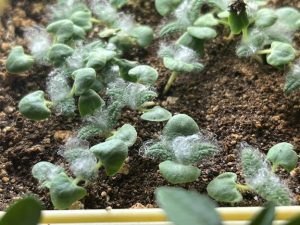
Prune relevant woody plants
Pruning improves the health of your plants, removes unsightly damaged or dead tissue, and manages the habit of the specimen to keep it from growing unruly or inconvenient. UMaine Cooperative Extension Bulletin #2169, Pruning Woody Landscape Plants covers key concepts, includes 5 informative how-to videos, and even has a pruning calendar to guide you through pruning tasks all year. Remember to always use clean, sharp tools (see just below!).
Inventory, clean, and maintain garden tools
March is a great time to make sure your tools are cleaned, oiled, and in working order, and to repair or replace anything that might be broken or missing. Taking care of tools greatly increases their useful lifespan, saving on your gardening budget. The University of Wisconsin Cooperative Extension’s Maintaining Lawn and Garden Tools provides good information on the topic.
Make a trip to enjoy Maine maple products
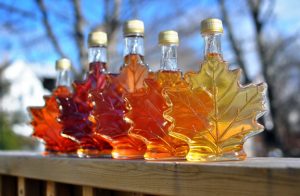
If you’ve never visited a sugar shack, it’s a rite of passage you shouldn’t miss. This year’s Maine Maple Sunday Weekend is March 22–23, though you can search options for other maple events throughout the month at the Real Maine website. Enjoy what our creative local maple producers have to offer.
An Ode to Snags
By Hannah Mullally, U.S. Fish and Wildlife Service Partners for Fish and Wildlife Biologist, Maine Field Office
As winter comes to a close and spring bursts forth, you’ll see the subtle blush of color emerge among the branches of your tree line. One or two trees might catch your eye, not because of their spring hues, but due to their lack of color and buds. On closer inspection, these trees might have peeling bark, mushrooms growing on the trunk, or other signs that the tree is dead or dying. These trees are snags, a wildlife habitat powerhouse.
Snag safety
Before
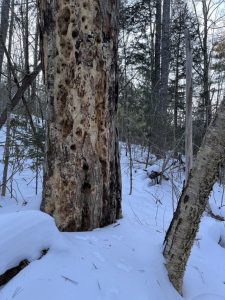
diving into the importance of snags, a word about safety. By definition, snags are standing dead or dying trees. Although an important part of nature, snags should not be retained when they may be a hazard to people or property. Contact a licensed arborist to remove a snag in an unsafe location.
The importance of snags
Snags, cavity trees (living trees with existing cavities), and the downed wood that comes from them provide habitat for a huge swath of wildlife. In Maine, there are over 70 animal species (not including insects or fish) that use this woody material (1). Birds are often the first example that come to mind. Many species of birds use snags and cavity trees to nest, rest, and forage. One of these is Maine’s state bird, the black-capped chickadee. They are primary excavators, meaning they make the initial cavities in snags to forage and create their nest space. Bats also frequently use snags to roost during the day, often under peeling bark or within cavities or crevices. Fishers and pine marten raise their young in tree cavities and use cavities for resting spots. These are just a few examples of how wildlife uses snags. If you get the chance to watch a snag or place a game camera on one, your reward will be great!
Snags in a woodlot
Woodlot owners have an opportunity to incorporate snags into your forest management plan. A good place to start is retaining at least four cavity trees or snags per acre, ideally with one tree over 24-inch diameter at breast height (DBH) and three trees over 14-inch DBH (1). If you don’t currently have snags, you can retain live trees at these diameters that are more likely to become snags. Trees more likely to become snags are those with defects such as broken large limbs, dieback in the crown, and cracks from lightning damage. It is important to have snags and cavity trees of various DBH because different sized snags accommodate different wildlife species. In general, the larger the snag DBH, the larger the animal it can accommodate.
New life
Although snags are dead or dying, it is just the beginning of a new life for the tree. After a snag falls, the material continues to provide vital wildlife habitat. Big, hollow logs can serve as dens for large mammals. Ruffed grouse “drum” on large logs to attract females and define their territories. With more decay, the moist, soft logs will be used by amphibians, reptiles, and many invertebrates for shelter. Finally, highly decomposed logs will be colonized by mycorrhizal fungi, supporting its host tree’s growth.
This spring, among the new growth and beautiful blooms, take a pause to appreciate the scraggly snags. Their beauty lies not in their showy colors, but in their humble support of Maine’s wildlife.
- Bulletin #7147, Biodiversity in the Forests of Maine: Guidelines for Land Management. 2008 edition. The University of Maine Cooperative Extension.
Backyard Bird of the Month: Down Woodpecker
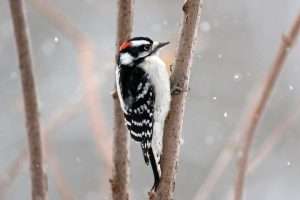
By Maine Audubon Staff Naturalist Doug Hitchcox
The smallest woodpecker in Maine, the Downy Woodpecker is a common species that can be found around any deciduous woods. This species looks very similar to its larger cousin, the Hairy Woodpecker, and the alliterative mnemonic that “downy is diminutive” may help you remember which is smaller. Downies are active around feeders throughout the winter, and you may start hearing them even more as they begin to sing despite the cold and snow. Remember that a song is defined as a noise that a bird makes to defend its territory or attract a mate. Woodpeckers song is mechanical rather than vocal and is the rapid drumming you can hear especially in the early morning. Differing from the slow pecking woodpeckers do when searching for food, drumming is a rapid burst, lasting only a couple of seconds, and usually done against a substrate to maximize noise output, like a hollow dead branch. Keep your ears open for woodpecker songs as the days get longer.
Gardening Podcasts
By Barbara Harrity, Penobscot County Master Gardener Volunteer
Today’s gardeners enjoy a wide range of useful resources—books, Extension offices, television shows, websites, and now podcasts. As you might imagine, gardening-related podcasts have become more common, and hosts approach the subject from many different angles—organic, homesteading, flowers, houseplants, garden design, farming, you name it.
Confession time: I’m not really a podcast listener. But I am interested in exploring home gardening resources, so I thought I’d see what’s available in the podcast genre. My general internet search produced a list of more than 20 podcasts, which I winnowed down to 5. The links below are to websites, but you can also find these podcasts on streaming apps.
- Cultivating Place is a public radio co-production with North State Public radio, based in Northern Cali Host Jennifer Jewell focuses on “how and why we garden—what we mean when we garden.” Episodes are about an hour long. Interesting recent episode: Resolution Support: Interview with Nicole Burke author of The 5-Minute Gardener
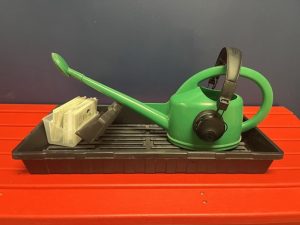
Photo by Kate Garland.
- A Way to Garden With Margaret Roach is a 25-minute public-radio program that airs weekly on Connecticut’s Robin Hood Radio and as a podcast on all the major platforms. I really liked the way the website was arranged with a list of recent episodes, along with lists of listener favorites and native-plant-related episodes. Interesting recent episode: enhancing the winter garden, with Warren Leach.
- Encyclopedia Botanica, a listener-supported project of the Seattle Urban Farm Company, focuses on vegetable, fruit, and cut-flower gardening. Each episode is a conversation between host Hilary Dahl and a guest contributor. The website has a handy list of podcast and blog archives by topics. Episodes are around 35-45 minutes long. Interesting recent episode: Fall Vegetable Garden Care and Soil pH
- Maritime Gardening is less sophisticated than the three podcasts above, but I like its focus on a region similar to Maine. Episodes are ~30 minutes. Interesting recent episode: Things to Do in December.
- The Native Plant Podcast hasn’t listed a new episode since January 2024, but the archived episodes reach back to 2016. According to the website, the podcast grew “from a friendship forged at the Cullowhee Native Plant Conference many moons ago, [and] this rock star garage band has brought podcasting to a whole new level. I’m not saying that’s a high level, just a new level. :)” Episodes are approximately an hour long. Interesting recent episode: Uli Lorimer and his Northeast Native Plant Primer.
Podcasts are a great way to occupy your mind while your hands are busy. So as I start seeds or make paper pots this spring, I plan to check out these podcasts above. If any readers have favorite gardening podcasts that I’ve overlooked, let me know (bharrity324@gmail.com), and I’ll update this list for a later issue of Maine Home Garden News.
Pollinator Ponderings: My Journey to Loving Native Plants
By Debbie Schulz, Cumberland County Master Gardener Volunteer
My journey to loving native plants started with dislike, followed by discovery, exploration, and finally embracing.
I remember the exact day my native plant journey began. After a long day at work, I was trying to keep my eyes open in a darkened room watching a slide presentation about growing native plants. The speaker had slide after slide of caterpillars and finished off with a side-by-side picture of two plants: one was extensively eaten by caterpillars, the other was not. The eaten plant was a native plant, and the other was nonnative. I remember thinking I wouldn’t want to grow the native plant because I would need to spray to kill the caterpillars. My husband, however, understood the principle I missed and immediately began the hunt for native serviceberries and elderberries.
If you had asked me back then what a native plant was, I would have probably described it as a plant growing in fields or woods. I knew about invasive plants, but not about what made a plant native. Again my husband intervened and signed us up for a native plant walk in Robinson Wood in Cape Elizabeth with Heather McCargo, the founder of Wild Seed Project. At Christmas, seed packets from the Wild Seed Project showed up in my stocking. That winter, I potted up the native seeds, and in spring, after one of the worst winters I had experienced in New England, tiny seedlings emerged. Some were immediately eaten by slugs, but most survived.
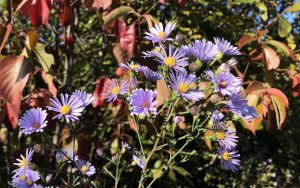
I was living in a house with a large lawn and not much else, so in the spring I went to every plant sale I could find and finished with the last plant sale of the spring at Maine Audubon. I came a little after it began and had to park way down the street. I was met by people quickly putting every single plant in their wagons and decided I had better get shopping before all the plants were gone. During the early years of the pandemic, I continued scouting local nurseries for native plants as entertainment. I saw it as a treasure or scavenger hunt.
My favorite native plant is the smooth blue aster. It doesn’t have the browned bare legs of the New England aster and is happy to self seed without taking over. It’s a perfect plant to introduce reluctant gardeners to the joy of native plants. I have also found that when nonnative plants underperform in the garden, it has become much easier to replace them with native plants. After another cold winter, the forsythia only bloomed where it had been covered in snow. I thought, well if it can’t bloom in the spring, what good is it? So I replaced it with a mountain maple. Similarly, while pruning a Rosa rugosa and losing lots of skin to the thorns, I found I could pull it all out and replace it with a native.
Some people immediately love native plants and others need to warm up to them. Don’t worry if you are still in the warming up phase. It should pass soon.
Book Review: The Serviceberry by Robin Wall Kimmerer (Scribner 2024,109 pp)
By Clara Ross, Penobscot County Master Gardener Volunteer
I found this to be a thought-provoking and informative book written by the same author who gave us Braiding Sweetgrass in 2013. Kimmerer is a member of the Potawatomi Nation, as well as a professor of environmental biology at the State University of New York College of Environmental Science and Forestry (SUNY-ESF) and founder of the Center for Native Peoples and the Environment.
Using Amelanchier spp., commonly known as serviceberry, Kimmerer teaches us how better understanding of this one plant species can help us view our environment differently. She shows how serviceberries give us in abundance as a result of the interdependence of all human and nonhuman life forms. She points out that, through photosynthesis, water, plants, and soils, as gifts from the Earth (along with the Sun), provide the oxygen we need to breathe.
Kimmerer encourages a “gift” economy shared with gratitude, connection, and “enough-ness.” She encourages a swapping-of-sorts economy in which, for example, I may give you some berries because I have excess and then you may make a pie with the berries to feed a person who is unhoused. Some of us may already practice this when we distribute our excess zucchini crop all over town!
I learned that Indigenous peoples have used this very same gift economy: sharing whatever they had knowing that another member of the community would share with them when they had abundance. They used this manner of survival, as they traveled to the food in season without needing to own property and accumulate wealth. Plants were gratefully used for food and medicine, and to feed the deer, moose, and birds, refuge for butterfly larvae, splints for baskets, etc.
All of this in contrast with the accumulating goods for “later” economy with careful calculations of supply and demand, which leads to greed and a “cannibal” ecology. It’s traditional in our American culture to flaunt our possessions to show how much better off we may be than others. We use our Mother Earth, which has provided us with all that we need to survive, for personal gain. We buy and sell water and rocks! We strip the forests for greed.
Kimmerer asks us to find a way to give back to Mother Nature, our nurturer. So I ponder: Will I donate land or money for conservation? Will I speak out on land use? change my diet to nutritionally dense foods? reduce my carbon footprint? write a book review in support of honoring the gifts nonhuman life forms give to me?
Invasive Species Awareness Week in Maine
Courtesy of Maine Department of Agriculture, Conservation and Forestry
Governor Janet Mills has officially proclaimed February 24 to March 2, 2025, as Invasive Species Awareness Week in Maine. This proclamation coincides with National Invasive Species Awareness Week (NISAW), an annual event dedicated to raising public awareness about the environmental and economic threats posed by invasive species. The week serves as a call to action for individuals, communities, and organizations to help prevent and manage invasive species across the state.
“Invasive species threaten Maine’s natural landscapes, forests, and waters,” said Governor Mills. “By taking proactive steps to prevent their spread, we can help protect our environment, economy, and way of life for generations to come.”
NISAW is an annual event recognized across the United States to promote knowledge and action in the fight against invasive species. Invasive species threaten ecosystems, agriculture, and economies, making prevention and management crucial to preserving natural habitats and local industries.
“Maine’s forests and agricultural resources are vital to our economy, environment, and way of life,” said Amanda Beal, Commissioner, Maine Department of Agriculture, Conservation and Forestry. “The Maine Forest Service’s Forest Health & Monitoring team and the Maine Bureau of Agriculture, Food and Rural Resources’ Plant Health Program play an essential role in protecting these assets from invasive pests. Their efforts help safeguard our natural resources today and ensure that future generations are equipped with the knowledge and tools to continue this critical work.”
Here are some ways individuals can contribute to slowing or preventing the spread of invasive species in Maine:
- Identify and Remove Invasive Plants: Familiarize yourself with early-detection, invasive plants like Japanese stiltgrass, mile-a–minute vine, report them with photos to horticulture@maine.gov, and volunteer with local land trusts or conservation commissions to remove these and established invasives like Asiatic bittersweet from public lands. See the Maine Invasive Plant Field Guide for help.
- Identify Emerald Ash Borer Signs: Learn to recognize emerald ash borer infestation signs, particularly during winter when “blonding” on ash trees is noticeable. Report findings using the EAB Report Form.
- Report Tree of Heaven Sightings: Keep your eyes out for tree of heaven, which hosts the invasive spotted lanternfly. Report sightings to mnap@maine.gov.
- Combat Browntail Moth: Check hardwood trees and shrubs for browntail moth winter webs and eliminate them before April, when the caterpillars become active.
- Prevent the Spread of Invasive Earthworms: Take measures to prevent the spread of invasive earthworms, which disrupt forest soils, by avoiding the movement of plants, soil, mulch, or leaves.
- Use Local Firewood: When camping, avoid transporting firewood to prevent the spread of invasive pests. Purchase firewood locally. Check Firewoodscout. org for local options.
- Practice Play Clean Go: Clean hiking gear, ATVs, and other equipment to prevent invasive species from spreading to new locations.
- Follow Clean, Drain, Dry: Protect waterways by cleaning, draining, and drying boats and equipment after use. Consider joining organizations like Lake Stewards of Maine for additional involvement.
- Explore Invasive Species Programs run by the State of Maine.
- Contribute to citizen science efforts to document invasive species by setting up a free account with iMap Invasives.
- Follow Maine Invasive Species Network Facebook page.
“Through monitoring, management, and education, DACF experts are on the front lines of preserving Maine’s forests, farms, and ecosystems for the long term,” continued Commissioner Beal.
About Invasive Species Awareness Week in Maine
The Maine Department of Agriculture, Conservation and Forestry invites everyone to join in Invasive Species Awareness Week in Maine by using this opportunity to learn more about invasive species impacting our ecosystems, agriculture, and natural resources. Invasive pests and diseases threaten not only forest health—such as the hemlock woolly adelgid and beech leaf disease—but also freshwater systems, farmland, and native wildlife habitats. These disruptions weaken biodiversity, reduce resilience to climate change, and create economic challenges for communities that rely on Maine’s natural resources. By taking collective action and raising awareness, Mainers can help protect the state’s environment and economy from invasive species threats. To learn more about Maine’s invasive species prevention efforts, visit http://www.maine.gov/invasives.
Spring Gardening Webinars: Gardening for the Future
By Rebecca Long, Coordinator of Horticulture Training Programs
With longer days ahead, I’m already thinking about spring—deciding which plant sales to attend, which projects to tackle first in the garden, and wondering which plants made it through the winter. As I’m adding to my plant wishlist, I’m also looking further ahead and wondering what will the growing conditions in Maine be like in 5, 10, or even 20 years? And how can I make smart planting decisions now to prepare?
In addition, I’m considering shorter-term strategies to make my garden more resilient in the face of increasingly unpredictable weather—droughts, extreme rain events, and tough winter conditions.
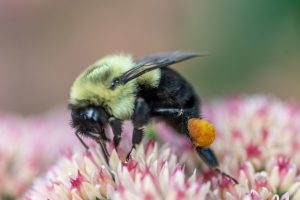
If this resonates with you, or if I’ve piqued your curiosity, I hope you will join our upcoming spring webinar series; Gardening for the Future, held on Wednesdays from 6:00 to 7:15 pm. The series starts on March 12 with Gardening in a Changing Climate: What Maine Gardeners Need to Know. This first session will provide an introduction to the impacts of climate change on Maine gardens and share basic techniques for building garden resilience. We recommend registering for this session, either to watch live or view the recording, if you plan to attend any other webinars in the series.
On March 19, we’ll be joined by Hannah Mullally, from the US Fish and Wildlife Service, who will present: Backyard Resilience for Pollinators. You will learn about the interdependence of pollinators, plants, and the environment. We will cover what you can observe in your own backyard and actions everyone can take to create resilient backyard habitat for pollinators now and in the future.
Our last webinar for the month, Becoming a Resilient Vegetable Gardener, on March 26, will feature Carrick Gambell who will share strategies for vegetable gardeners to prepare our gardens for success and bounce back from the inevitable weather challenges.
Check back next month for updates on our April webinars!
Maine Weather and Climate Overview
By Dr. Sean Birkel, Assistant Extension Professor, Maine State Climatologist, Climate Change Institute, Cooperative Extension University of Maine
After a warm start to winter, temperatures since the third week in January have been mostly below normal statewide, bringing the coldest stretch of weather since winter 2022 (with the two intervening winters being among the warmest on record). Observations from the Bangor Intl. Airport show minimum daily temperature having dipped below 0°F on seventeen occasions, five of which were readings of -10°F or colder. For comparison, January–February 2024 registered only three days with minimum temperatures below 0°F. Daily station observations from Bangor, Caribou, and Portland through the 26th suggest that February 2024 will rank in the top 1/3 coldest. A series of snowstorms over the past month have also brought Maine’s snowpack to near normal for this time of year. However, because of drought signal carryover from last fall, much of Maine continues to register either abnormal dryness or moderate drought, where streamflows and groundwater levels are generally below or much-below normal across the southern half of the state parallel to the coast. Additional drought information and resources can be found on the Maine Emergency Management Agency Drought Task Force webpage.
In the latest 10-day weather forecast (morning February 27): Temperatures are trending milder as daylight hours increase with onset of climatological spring (March-May), but a coldwave March 2–4 is forecast to bring morning temperatures back into the single digits (or subzero in the north and west). Then an active weather pattern may develop bringing both rain and snow to the state across the forecast period. The monthly outlook for March (see below) calls for equal chances of either above or below normal temperature and precipitation. The March–May seasonal outlook predicts above normal temperature and equal chances of above or below normal precipitation. As always, visit weather.gov for the latest weather forecast for your area. Detailed winter weather guidance is available from the National Weather Service Gray and Caribou forecast office webpages. For questions about climate and weather, please contact the Maine Climate Office.
| Product | Temperature | Precipitation |
|---|---|---|
| Days 6-10: March 4-8 (issued Feb 26) | Near Normal | Above Normal |
| Weeks 8-14: Feb 4–10 (issued Feb 26) | Below Normal | Above Normal |
| Monthly, February (issued Feb 20) | Equal Chances | Equal Chances |
| Seasonal: Feb–Mar–Apr (issued Feb 20) | Above Normal | Equal Chances |
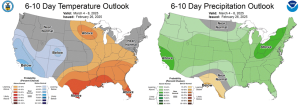
Consider making a contribution to the Maine Master Gardener Development Fund. Your dollars will support and expand Master Gardener Volunteer community outreach across Maine.
Your feedback is important to us!
We appreciate your feedback and ideas for future Maine Home Garden News topics. We look forward to sharing new information and inspiration in future issues.
Subscribe to Maine Home Garden News
Let us know if you would like to be notified when new issues are posted. To receive e-mail notifications, click on the Subscribe button below.
University of Maine Cooperative Extension’s Maine Home Garden News is designed to equip home gardeners with practical, timely information.
For more information or questions, contact Kate Garland at katherine.garland@maine.edu or 1.800.287.1485 (in Maine).
Visit our Archives to see past issues.
Maine Home Garden News was created in response to a continued increase in requests for information on gardening and includes timely and seasonal tips, as well as research-based articles on all aspects of gardening. Articles are written by UMaine Extension specialists, educators, and horticulture professionals, as well as Master Gardener Volunteers from around Maine. The following staff and volunteer team take great care editing content, designing the web and email platforms, maintaining email lists, and getting hard copies mailed to those who don’t have access to the internet: Abby Zelz*, Annika Schmidt*, Barbara Harrity*, Kate Garland, Mary Michaud, Michelle Snowden, Naomi Jacobs*, Phoebe Call*, and Wendy Robertson.
*Master Gardener Volunteers
Information in this publication is provided purely for educational purposes. No responsibility is assumed for any problems associated with the use of products or services mentioned. No endorsement of products or companies is intended, nor is criticism of unnamed products or companies implied.
© 2023
Call 800.287.0274 (in Maine), or 207.581.3188, for information on publications and program offerings from University of Maine Cooperative Extension, or visit extension.umaine.edu.
